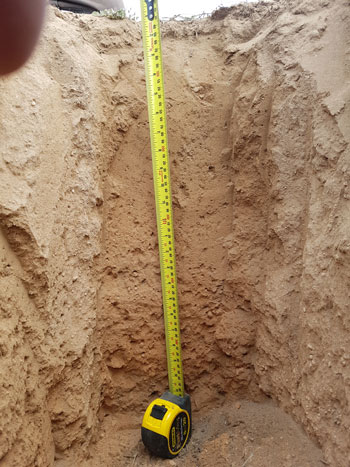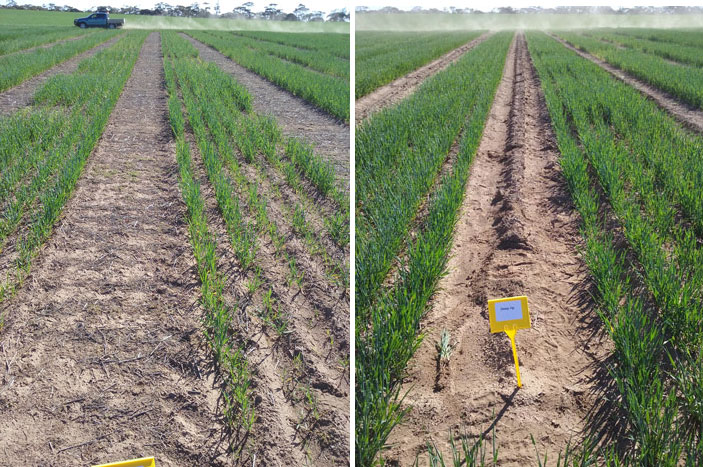Key points
- Highly calcareous soils severely restrict crop growth and yield in multiple ways
- New research aims to tackle the complex range of issues, which include low water use efficiency and phosphorus availability
Highly calcareous soils are very difficult to farm and the keys to improving their productivity are far from clear.
 A typical highly calcareous soil profile of the Upper Eyre Peninsula. Photo: Nigel Wilhelm
A typical highly calcareous soil profile of the Upper Eyre Peninsula. Photo: Nigel Wilhelm
Calcarosols occupy about 60 per cent of the cropping soils in south-eastern Australia, with more than 1.1 million hectares of South Australia’s cropping area highly calcareous. Highly calcareous soils limit the effectiveness of improved agronomic practices, with poor early crop vigour and low water use efficiency.
Constraints include low phosphorus status, poor nitrogen cycling, severe fertiliser toxicity during germination, low water-holding capacity, high burden of Rhizoctonia and, at depth, extreme pH, sodicity, bicarbonate toxicity and salinity.
GRDC has commissioned two partner projects, one led by the Cooperative Research Centre for High Performance Soils (the Soil CRC) and the other by CSIRO, to improve the understanding of these soils, with the aim of increasing water use efficiency and farm profitability.
They will bring together a multidisciplinary team from Primary Industries and Regions South Australia, the NSW Department of Primary Industries, CSIRO, Agricultural Innovation & Research Eyre Peninsula and MacKillop Farm Management Group.
Tackling the issues
The studies will investigate topsoil issues such as nutrient deficiencies and toxicities, Rhizoctonia and problems with dry seeding, as well as how the common but not well understood subsoil issues of extremely high pH, sodicity, boron toxicity and salinity affect crop production.
Phosphorus nutrition is a particular issue on these soils because the nutrient is rapidly converted to insoluble forms. Fluid phosphorus is more effective than granular fertiliser in these soils but is not commonly used due to price and added logistical issues. Understanding how fertiliser phosphorus supply is influenced by wetting and drying and the presence of multiple constraints in these unique soils will help to identify new management options, including the potential value of novel products and whether granular phosphorus can be used more effectively.
The majority of the field work will be conducted on the Upper Eyre Peninsula with two major field sites on highly calcareous grey sandy soils (typical of these extreme soils) and one on a moderately calcareous soil (more representative of the rest of calcareous soils on the Eyre Peninsula and the SA and Victorian Mallee regions). A satellite site in south-eastern SA will contrast the behaviour of a calcareous soil in a higher-rainfall environment.
A demonstration site to showcase the type of work these projects will undertake was set up in 2020 on the Upper Eyre Peninsula at Poochera.

A demonstration plot at Poochera on the Upper Eyre Peninsula shows improvements are possible. The plot on the left was managed with inputs typical for the district, while the one on the right was deep-ripped with inclusion plates prior to seeding. Patches in the plot on the left are caused by Rhizoctonia. Photos taken mid-season 2020. Photo: David Davenport
It showed that deep ripping with inclusion plates improved barley growth substantially, which was a surprise because previous deep ripping attempts have shown little benefit on these soils − albeit without inclusion plates. Extra fertiliser in the seed row caused little damage in the trial despite very low soil moisture at seeding, even though this is often a severe problem under these conditions. Strategies to control Rhizoctonia with a seed dressing and extra fertiliser also had little benefit, although deep ripping itself reduced Rhizoctonia.
This demonstration has highlighted that these highly calcareous soils are very difficult to farm and the keys to improving their productivity are far from clear.
More information: Dr Nigel Wilhelm, 0407 185 501, nigel.wilhelm@sa.gov.au; Dr Therese McBeath, 08 8303 8455, therese.mcbeath@csiro.au

























































